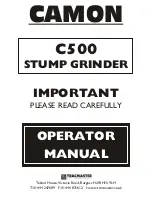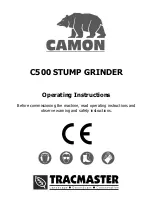
www.scheppach.com /
+(49)-08223-4002-99 /
+(49)-08223-4002-58
GB | 19
•
The machine may only be used, maintained or re
-
paired by trained persons who are familiar with the
machine and have been informed about the dan-
gers. Unauthorized modifications of the machine
exclude a liability of the manufacturer for damages
resulting from the modifications.
•
The machine is intended for use only with original
spare parts and original tools from the producer.
•
The equipment is allowed to be used only for its
prescribed purpose. Any other use is deemed to
be a case of misuse. The user/operator and not
the manufacturer will be liable for any damage or
injuries of any kind resulting from such misuse.
• Please note that our equipment has not been de-
signed for use in commercial, trade or industri-
al applications. Our warranty will be voided if the
equipment is used in commercial, trade or indus-
trial businesses or for equivalent purposes.
Residual risks
The machine is allowed to be used only for its in
-
tended purpose! Even when the equipment is used
as prescribed it is still impossible to eliminate cer-
tain residual risk factors. The following hazards may
arise in connection with the machine‘s construction
and layout:
• Contact with the grinding wheel where it is not-
covered.
• Catapulting of parts from out of damaged grind-
ing wheels.
• Catapulting of workpieces and parts of workpiec-
es.
•
Damage to hearing if essential ear-muffs are not
used.
• Lung damage if no suitable protective dust mask
is used.
•
Health damage caused by hand-arm vibrations if
the equipment is used over a prolonged period or
is not properly guided and maintained.
• The use of incorrect or damaged mains cables can
lead to electrical injuries.
• Although having regarded all considerable rules
there may still remain not obvious remaining haz
-
ards.
•
Minimize remaining hazards by following the in
-
structions in ”Safety Rules”, ”Use only as author
-
ized” and in the entire operating manual.
5. Safety instructions
General power tool safety warnings
m
WARNING!
Read all safety warnings, instructions, illustra
-
tions and specifications provided with this power
tool.
Failure to follow all instructions listed below may re
-
sult in electric shock, fire and/or serious injury.
Save all warnings and instructions for future ref
-
erence.
The term “power tool” in the warnings refers to your
mains-operated (corded) power tool or battery-oper
-
ated (cordless) power tool.
1. Work area safety
a)
Keep work area clean and well lit.
Cluttered or
dark areas invite accidents.
b)
Do not operate power tools in explosive at
-
mospheres, such as in the presence of flam
-
mable liquids, gases or dust.
Power tools cre-
ate sparks which may ignite the dust or fumes.
c)
Keep children and bystanders away while op
-
erating a power tool.
Distractions can cause you
to lose control.
2. Electrical safety
a)
Power tool plugs must match the outlet. Never
modify the plug in any way. Do not use any
adapter plugs with earthed (grounded) power
tools.
Unmodified plugs and matching outlets will
reduce risk of electric shock.
b)
Avoid body contact with earthed or grounded
surfaces, such as pipes, radiators, ranges
and refrigerators.
There is an increased risk of
electric shock if your body is earthed or grounded.
c)
Do not expose power tools to rain or wet con
-
ditions.
Water entering a power tool will increase
the risk of electric shock.
d) Do not abuse the cord. Never use the cord
for carrying, pulling or unplugging the pow
-
er tool. Keep cord away from heat, oil, sharp
edges or moving parts.
Damaged or entangled
cords increase the risk of electric shock.
e)
When operating a power tool outdoors, use an
extension cord suitable for outdoor use.
Use
of a cord suitable for outdoor use reduces the risk
of electric shock.
f)
If operating a power tool in a damp location
is unavoidable, use a residual current device
(RCD) protected supply.
Use of an RCD reduc-
es the risk of electric shock.
3. Personal safety
a)
Stay alert, watch what you are doing and use
common sense when operating a power tool.
Do not use a power tool while you are tired or
under the influence of drugs, alcohol or medi
-
cation.
A moment of inattention while operating
power tools may result in serious personal injury.
b)
Use personal protective equipment. Always
wear eye protection.
Protective equipment such
as a dust mask, non-skid safety shoes, hard hat
or hearing protection used for appropriate condi-
tions will reduce personal injuries.
















































